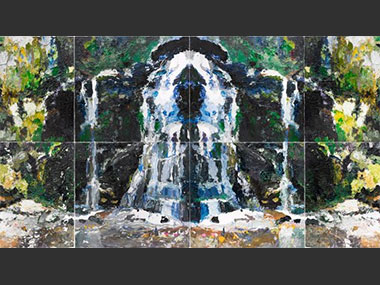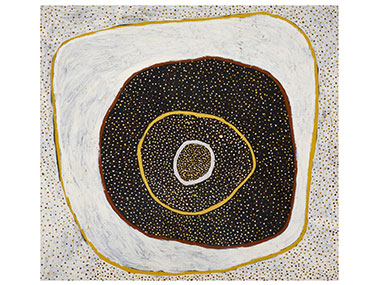CULTURE v POLITICS IN SYDNEY

Ben Quilty's 'Fairy Bower Rorschach' (2012), the inspiration for the Art Gallery of NSW's exhibition
Posted by Jeremy Eccles | 07.01.16
Gallery: Art Gallery of NSW
Dates:
19.12.15
: 01.05.16
After all the trumpeting about the two big International Art Series shows on this summer in Sydney – 'The Greats' from the Scottish National Galleries at AGNSW and Grayson Perry from Essex at the MCA – there was barely a clap-stick beat as both those institutions opened Indigenous art shows in the week before Christmas. Are they embarrassed, or just out of steam and PR budget??
Confounding too is fact that the venerable Art Gallery is playing international politics with its show, 'When Silence Falls', mixing black and white, urban and remote, national and overseas artists as it considers historical themes of violence – the strong over the weak; while the shiny new MCA simply feels we need to experience the very special ancient culture of the Tiwi Islands, a mere 80kms off Darwin, but unique in the Aboriginal pantheon.
Let's start simply. Though of course, Tiwi culture is anything but simple. For instance, you can't just assume a knowledge of their fundamental belief system involving a family of legendary men and women (and a baby), infidelity, and the introduction of death into the immortality of this once-upon-a-time Garden of Eden. The ceremony devised to handle this tragedy – the Pukumani – and the Kulama Yam ceremony needed as a counter-balance to it to deal with fertility, initiation and new life, are central to much Tiwi art. They really need to be explained
by curators Natasha Bullock and Keith Munro in detail to appreciate the works on the gallery walls from nine featured artists. I suppose I'd find it in the catalogue, but suspect more is needed on the walls.
What we do have is a great sense of the recent art history of Bathurst and Melville Islands, as we call them. I wonder what the Tiwis call them? Jennifer Isaacs' definitive book on the Tiwi suggests that the islands are too big to need a name – only 9 regions are named. Even before art was bursting out of the Painting Room down south at Papunya, pottery and print-making were happening thanks to the hunger of a trio of young men – Bede Tungutalum, Giovanni Tipungwuti and Eddie Puruntatameri – and the patronage of the Catholic Church. That was 1968/9. Barks and wood-carving pre-dated this in the hands of individuals. But the exhibition opens with a suite of prints from woodblocks made in 1969 and re-discovered in 1996 – originally printed with the help of a large metal spoon pressing paper into the inked block, but tackled more professionally at the semi-industrialised Tiwi Design studio in the 90s.
These realistic images soon mutated to involve ceremonial designs derived from body painting, totemic symbols and the circularity that links the shape of the yam to the grounds where it is celebrated, which were now impressed on canvas in art centres at Milikapiti and Munupi. Timothy Cook is hailed as the master of the Kulama painting – and a fine work on a rare white background which draws the eye in through five concentric circles to an intensely dotted centre has been commissioned by the MCA. But it's hard not to see Nina Puruntatameri's 'Kulama' (2013) as a masterly and innovative interpretation of the same theme.
A life of ceremony need not be an inexpedient one. To create the patterns necessary to disguise participants from hostile spirits, Tiwi invented the pwoja, a carved wooden comb that could apply multiple dots in one go. Maria-Josette Orsto and Raelene Kerinauia have both transferred the technique to canvas brilliantly – the former representing the scarring that imposes the physical memory of the dead on a loved-one's body, and the latter linking the crocodile scales of her totem, memories of the husband who'd made her first pwoja and the 'bones of the tree' that's the literal translation of the word in a brilliant series of subtly varied abstract 'jilimara' patterns, all in different ochre tones.
Two challenges arise from the show called 'Being Tiwi'. Ian Cook is quoted as saying of the rarely performed Kulama ceremony that he paints, “It's just all lost forever now – it's all in the painting”. But can the painting survive meaningfully without the ceremony? And, while the dedicated print-maker Bede Tungutalum is still at work in his favoured medium, quoted as “thinking of a new painting about the universe”, other Tiwi artists seem to attempt prints as, I assume, a way into the mass market, but rarely match the power and immediacy of their paintings.
'When Silence Falls' at the AGNSW, “provides a voice for those who have been silenced. Encompassing painting, video and sculpture, the collection-based exhibition presents the work of contemporary Aboriginal artists alongside contemporary international artists. It considers the violence and loss of often-unacknowledged historical events––cultural displacement, political oppression, ethnic cleansing and massacres”.
That's the theory enunciated by Indigenous curator, Cara Pinchbeck. But what of the result? Well, on the big walls of galleries half way downstairs, it's strangely cool for such a potentially emotional exhibition. Deep captions certainly bump up the heart-rate, but apart from Vernon Ah Kee's furiously paint-splattered 'Brutalities 9' (2014), there's more thought about the show than passion. And he's visualising a perpetrator of violence – specifically a Turk involved in the Armenian genocide – rather than engaging us with the victims. Meanwhile, Judy Watson's 1993 work, 'internal landscape' moves mysteriously, with a female figure emerging from, or disappearing into Watson's Lawn Hill Country – earth to earth, etc. Compared to her evocatively named new commission, 'a picnic with the natives' (2015) - a euphemism for massacre - it has real feeling rather than offering decorative map of multiple massacre sites around the Gulf of Carpentaria on a brightly coloured background.
The trio of East Kimberley Gija artists are much more allusive. A positively Buddhist tolerance by Timmy Timms, Paddy Bedford and Rusty Peters towards the killers of their kin allows them to record the facts – pace Windschuttle's white blindfold – without rancour. The iconic boab tree at a Mistake Creek massacre site says it all so quietly in the gentle colours of the land – brown, black and white ochres. Mind you, I suspect Paddy Bedford's beautifully balanced 'Old Bedford' (1999) painting has nothing to do with the Killing Times in The Kimberley. For I was with him at the site of Old Bedford station – a place of personal rather than public grief. Paddy's mother had conceived a child with the station manager and gave birth to one of the district's first mixed-race children. Both tribes were outraged – and the babe was drowned by Gija women elders. Paddy expressed sorrow for his lost half-brother; but made no connection to the subsequent Bedford Downs massacre.
Another anomalous work is the collaboration of Wik artist Alair Pambegan with the multiple prize and commission winning urban artist, Tony Albert. They have a school of Pambegan's traditional Bonefish figures installed in Adelaide's Tarnanthi Festival as piscine bullets. In Sydney, Albert has referenced his outsize shells installed as an Indigenous war memorial in Hyde Park using traditional Wik patterns on what appear to be machine-made moulds. Perhaps, as intended, it's quite shocking.
Juxtaposed with the Aboriginal, several serious international players seek to complement the local subject-matter. Venice Biennale selection Fiona Hall hangs swinging black corpses made from video tape emanating from the violent films that brought about their ends. And American Kara Walker is surely referencing Good Ol' Southern slavery (via Tarantino's 'Django') in her laser-cut steel drama called, oddly, 'Burning African village play set'. Bill Kentridge offers an entertaining flipbook film full of ideas that seem to have scant relationship to the accompanying song about a South African massacre. And Doris Salcedo places the shoes of the Colombian Disappeared in niches – blaming government-backed militias, but not the FARQ rebel army, which surely were just as guilty.
And Ben Quilty seems to have kicked the exhibition concept off with his Rorschach painting from 2012, 'Fairy Bower Falls'. I'm pretty sure I've seen it before in Canberra without realising that it was a beautiful rendering of a Bundanoon landscape that was also the setting for an unofficial massacre of local Aborigines. The silence of the rushing waters portrayed matches the silence that WEH Stanner noted in our telling this part of Aussie history. Hence the exhibition's title.
So it's great to see an Indigenous curator offering a bigger picture than a purely Aboriginal art show, and escaping from the AGNSW basement. But was Cara Pinchbeck unnecessarily constrained by only being able to select works from the Gallery's own collection in seeking to make a mix of Indigenous and non-Indigenous really challenging? I have to assume, for instance, that William Yang's simple photograph of the bones of a juvenile hand sticking up from the soil of a rural massacre site in NSW isn't in the collection. For it is as memorable and moving for me as anything on offer in 'When Silence Falls'.
While the AGNSW show continues until 1 May, the MCA's Tiwi ends on 21 Feb, though the previous weekend (11/13 Feb) artists will be visiting from the distant Tiwi Islands. Both shows have catalogues. And, later news, thanks to the Federal Government's Visions funding, the Tiwi show will tour nationally for the next two years:
18 March – 8 May 2016
Artspace Mackay, Queensland
19 August – 6 November 2016
Murray Art Museum Albury, New South Wales
18 November 2016 – 22 January 2017
Tandanya National Aboriginal Cultural Institute, South Australia
10 February – 26 March 2017
Moree Plains Gallery, New South Wales
7 July – 10 September 2017
Glasshouse Port Macquarie, New South Wales
7 October – 16 December 2017
Lawrence Wilson Art Gallery, Western Australia
MCA | Being Tiwi
AGNSW | When Silence Falls
URL: www.mca.com.au, www.artgallery.nsw.gov.au
Share this:
»  del.icio.us
»
del.icio.us
»  Digg it
»
Digg it
»  reddit
»
reddit
»  Google
»
Google
»  StumbleUpon
»
StumbleUpon
»  Technorati
»
Technorati
»  Facebook
Facebook
Contact Details
Gallery: Art Gallery of NSW
Contact: Cara Pinchbeck - Curator of Aboriginal and Torres Strait Islander Art
Email: artmail@ag.nsw.gov.au
Telephone: +61 2 9225 1700 or 1
Address: Art Gallery Road Sydney Sydney 2000 NSW
Gallery: Museum of Contemporary Art
Contact: Curator, Aboriginal and Torres Strait Islander Programs
Telephone: +61 2 9245 2400
Address: Circular Quay West George Street The Rocks Sydney 2000 NSW

One of Raelene Kerinauia's 16 panel work, 'Jilimara' (2015) commissioned by the MCA for 'Being Tiwi'

Timothy Cook's brilliant 'Kulama' (2015) capturing the essence of the dying Yam ceremony
Where is the exhibition?
Further Research
Gallery: Art Gallery of NSW
Artists: Bede Tungutalum | Eddie Puruntatameri | Giovanni Tipungwuti | Ian Cook | Judy Watson | Maria-Josette Orsto | Nina Puruntatameri | Paddy Bedford | Raelene Kerinauia | Rusty Peters | Timmy Timms | Vernon Ah Kee
News Tags: AGNSW | Art Gallery of NSW | Cara Pinchbeck | Jeremy Eccles | MCA | Museum of Contemporary Art | Tiwi
News Categories: Australia | Blog | Exhibition | Feature | Industry | News
Exhibition Archive
- 10.10.17 | TARNANTHI 2017
- 11.08.17 | Natsiaas 2017
- 20.07.17 | APY ART DOMINATES THE WYNNE
- 17.07.17 | Anangu Artist Wins $100,000 Prize
- 14.07.17 | The End of AAMU
- 11.07.17 | ART ACROSS THE COUNTRY
- 11.07.17 | TARNANTHI IN OCTOBER
- 05.07.17 | TJUNGUṈUTJA - from having come together
- 13.06.17 | Ghost-Nets Straddle the World
- 07.06.17 | Grayson Perry Going Indigenous?
- 05.06.17 | Barks Bigger than Ben Hur
- 27.05.17 | NGA QUINQUENNIAL 2017
- 21.05.17 | Blak Douglas Finds Home at the NGA
- 21.05.17 | BRIAN ROBINSON WINS HAZELHURST WOP
- 18.05.17 | PARRTJIMA 2.0
Advertising

